Purpose – The main objective of the study is to identify and analyze the main factors that help with the attraction of FDI inflow to Kazakhstan and examine obstacles which might slow down the process of FDI in Kazakhstan and find solutions to improve it.
Methodology – the project is provided the secondary research method, subsequently, there are used collecting, synthesizing and assessing features of current data.. The theoretical framework in this study will be based on electic paradigm or “OLI” paradigm which is build up by “Dunning” studies and in accordance with factors which are influencing to the choice of a host market of Gilomre, O’s Donnel, Carson and Cummins.
Originality/value – This quantitative study based on secondary data for the period of 1995-2015. Secondary data used in this study include the annual values of FDI in Kazakhstan at USD rate, Kazakhstan inflation rate records, the annual value of GDP, etc. An econometric model has been used for analysis based on time series data of Kazakhstan economy for the selected period. Multiple regression models have been applied as an analytic technique.
Findings – Based on statistical data this research has indicated that the key factors that determine changes in FDI in Kazakhstan are natural resource, political stability, labor cost, and exchange rate of Kazakhstan Tenge to other currency proxies of the rate of change in the US dollar, although GDP, inflation rate and other factors also play a significant role in the country’s economic growth.
Foreign Direct Investment (FDI) have been playing an important role in the economic development of most developing countries it is claimed that FDI can create employment, increase technology development and improve the economic condition of the country. Therefore, most of these countries have taken various measures to attract FDI inflows, and Kazakhstan has not been left out in this struggle. This study examines the influence of various motives of the FDI inflow in Kazakhstan. The study reviews both FDI theoretical and empirical literature to identify the potential factors that motivate the inflow of FDI.
Various studies have shown that the relative importance of FDI motives is likely to vary between different types of FDI, that is, resource-seeking, market-seeking and efficiency-seeking FDI (Dunning, 1980). Furthermore, the relative importance of FDI motives may change over time, for instance, due to globalisation. Factors that have been brought out as motives of FDI in developing countries include political and macroeconomic stability, infrastructure quality, governance, and regulatory environment, openness to trade and investment promotion strategies (Agosin and Mayer, 2000) [1]. However, it is important to note that even though these factors have been empirically proven to be FDI motives, some motives may apply to some regions but not others. For instance, on average, countries in Sub-Sahara Africa (SSA) receive less FDI than other regions by virtue of their geographical location (Asiedu, 2003). However, it is important to note that even when factors apply to a particular region, they may not be applicable to a specific country within that region.[1]
The theoretical framework in this study will be based on electic paradigm or “OLI” paradigm which is build up by “Dunning” as mentioned in literature review and studies and according to factors which are influencing to the choice of a host market of Gilomre, O’s Donnel, Carson and Cummins (2003). As can be seen that number factors are mainly affecting to attract FDI in Kazakhstan Figure 1.
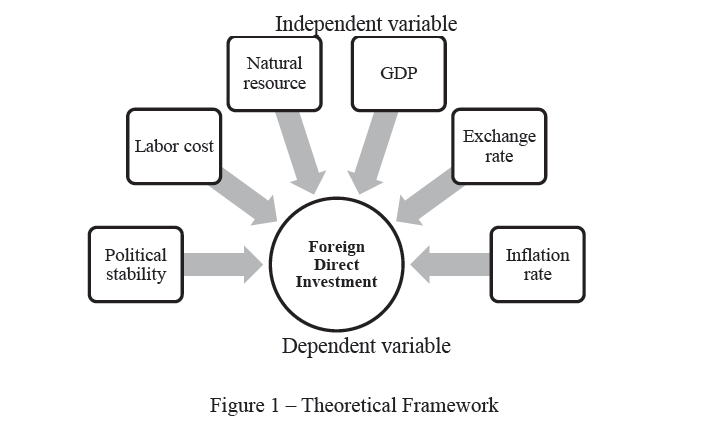
Figure 1 – Theoretical Framework
According to the Asian Development Bank Outlook (2015) report has pointed out that Central Asia’s growth slowdown is forecast to deepen this year. Fall down petroleum prices, economy recession in the Russian Federation, and weakness in other trading partners took their toll on Central Asia, where average growth drop to 2.9% in 2015 from 5.3% a year earlier. Forecasts of even lower petroleum prices and continued recession in the Russian Federation prompt a projection that average growth in the subregion will slow further in 2016 to 2.1%, with contraction forecast for Azerbaijan and growth at only 0.7% for Kazakhstan. Growth is projected to recover somewhat to 2.8% in 2017 on the strength of an improved external outlook and somewhat higher petroleum prices. Steep currency depreciation in several economies helped push average inflation to 6.2% in 2015 from 5.7% last year. The lagged inflation of depreciation in 2015 and possible further currency weakness in some economies are projected to propel average inflation to 10.8% in 2016 as acceleration occurs in all economies, with inflation reaching double digits in Azerbaijan, Kazakhstan, the Kyrgyz Republic, and Uzbekistan. Expected exchange rate stabilisation should help rein in average inflation in the sub-region to 5.9% in 2017 (Asian Development Bank, 2015).[2]
Kazakhstan has attracted significant foreign investment since independence and would like to see more come into the country. For 12 years (from 2005 to 2016) gross inflow of foreign direct investment (FDI) in Kazakhstan has increased by 2.6 times or 160,7%. Despite the general trend to increase during the period from 2005 to 2012, from 2013 to 2015 there is a reduction. If in 2013 the decline was recorded at 16.6%, in 2014 – 1.5%, in 2015 there was a record reduction in the gross inflow of foreign direct investment by 37.8%. [4]The strategic location of Kazakhstan in the Asian region, including factors such as mineral recourses, high educational level of the labor force have been determined and played significant role attracting a foreign direct investment in the overall inflow of external financial resources. In the period from 2005 to 2016 quarter 1, Kazakhstan attracted about of 226.7 billion dollars of foreign direct investment currently in Kazakhstan there are more than 20 thousand enterprises with participation of foreign capital. The inflow of foreign direct investment in Kazakhstan is carried out through the establishment of joint ventures, subsidiaries, privatisation of state enterprises with participation of foreign capital, transfer control of foreign firms to large industrial enterprises and investment banking sector [4].

Figure 2 – Gross FDI inflows in the economy of Kazakhstan from 2005 to 2016Q1 [5]
Netherlands and the United States are the main sources of capital contributions to Kazakhstan, which account each other for 65.6.9% and 24.6%, China 13.3%, Switzerland 15.6% and France 12.4%, United Kingdom 11.6 and Virgin Islands, Russia 9,8 and Italy 5,6 as well for the period from 2005 to 2016 1quoter billion.
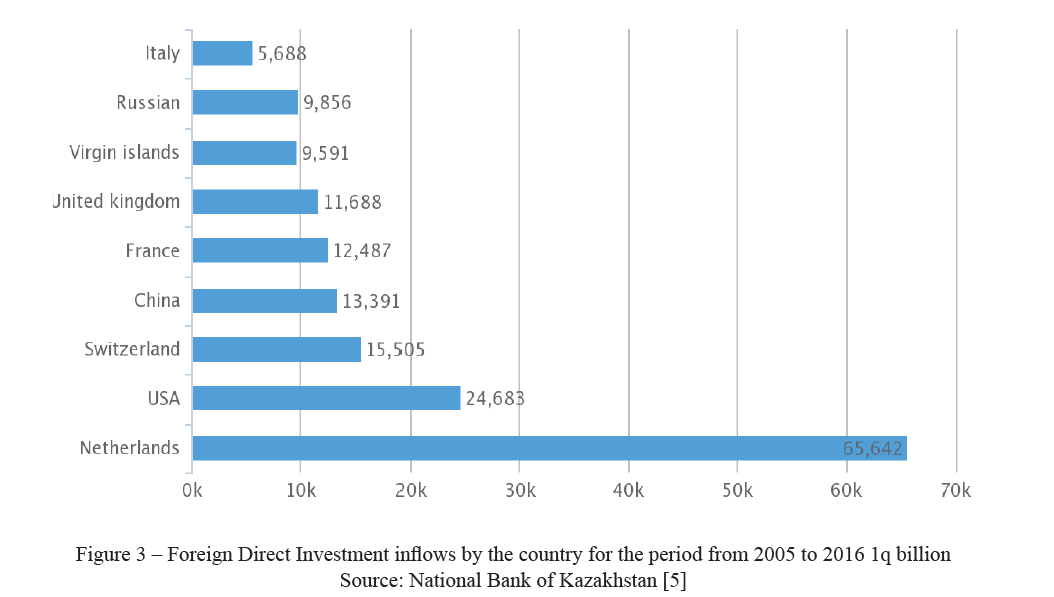
Figure 3 – Foreign Direct Investment inflows by the country for the period from 2005 to 2016 1q billion Source: National Bank of Kazakhstan [5]
Regarding the distribution of contributions by sector of destination, 73.7% concentrated in Mining and quarrying, 52% Professional, scientific and technical activities, 21.4% Processing industry, 16.5% Wholesale and retail trade.
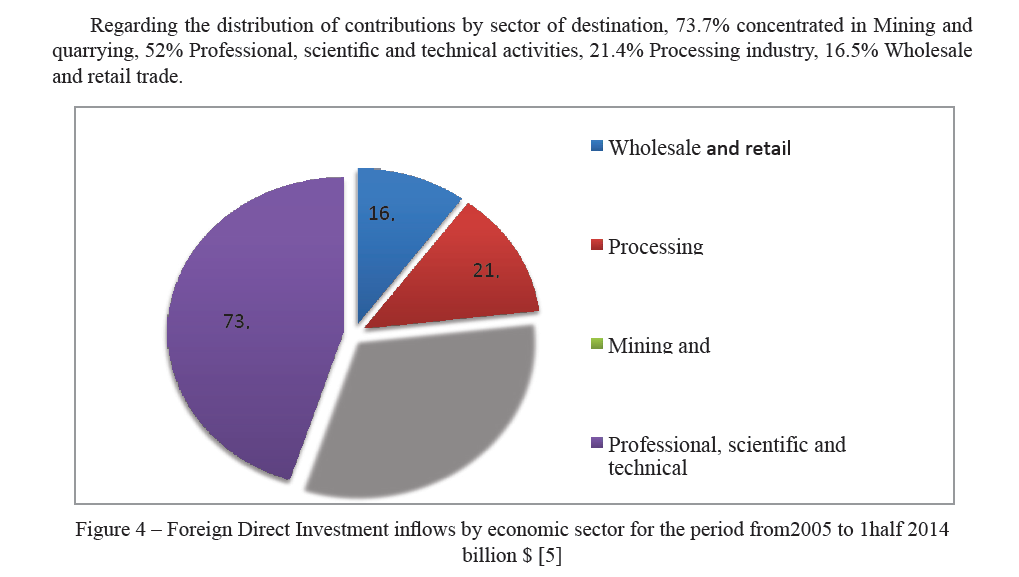
Figure 4 – Foreign Direct Investment inflows by economic sector for the period from2005 to 1half 2014 billion $ [5]
Total foreign direct investment (FDI) attracted in CIS countries and Georgia amounts to the US $49.1 billion. For the first time over several years of consistent growth, this indicator went down by 10%. This conclusion is suggested in the annual report by Eurasian Development Bank’s (EDB) Centre for Integration Studies Monitoring Mutual Investments in CIS Countries 2014. Russia attracted more than 85% of all attracted overall FDI in the CIS and Georgia (US $41.63 billion) and Kazakhstan 9% (US $4.37 billion).

Figure 5 – FDI inflow trend of Russian, Kazakhstan, Azerbaijan, Ukrainian, Belarusian and Georgian FDI in the CIS in 2008-2013 (US $ million) [6]
Methodology and Data
Descriptive statistics
To analyse the results, the study, start with descriptive statistics, whereby table 1 represent descriptive statistics of both dependent and independent variables which contain minimum, maximum, mean and standard deviation.
Table 1 – Descriptive statistic

FDI annual growth rate was the dependent variable of this study, whereby the values of FDI were taken at current dollar rate. Moreover, the annual rates of change in FDI from year to year were used as the dependent variable. As shown on above table, the mean rate of change in FDI from the 1995 year to the 2015 year was 7.737% whereby the highest attained rate of change in FDI was in 2015 which was 13.013% and the minimum rate change was 3.202% in 1996.
The Table 1 show the summary statistics which indicate the arithmetic average GDP rate was 5,3% whereby the highest GDP rate found in 2006 was 10.7% while the lowest rate was -8.4% realised in 1995.
Based on Table 1 it shows that the average level of country`s natural resource is 36.12% while the highest level of the availability natural resources was 55.187% in 2008 and the lowest level was in 1997 with 22.11%. The table 1 above describe that the descriptive statistic of labour cost was 85,057% mean rate, of the total average wage rate and the highest rate of wage was 106,153% in 2015 while the lowest wage was at 50% in 1995.
Political stability data were drawn from the global.economy.com whereby based on those data, it shows that the average level of countries stability is 0.10% while the highest level of stability was attained in 2009 with 0.75% and the lowest was in 1997 which was -0.53%. The index of Political Stability and Absence of Violence/Terrorism measures perceptions of the likelihood that the government will be destabilized or overthrown by unconstitutional or violent means, including politically-motivated violence and terrorism. The index is an average of several other indexes from the Economist Intelligence Unit, the World Economic Forum, and the Political Risk Services, among others [7].
The above Table 1 is the summary statistics shows that inflation rate was 18.06% mean rate of annual inflation and the highest rate of inflation was 176,2 % in 1995 while the lowest level of inflation was 5.1 in 2002. Exchange rate the descriptive statistic Table 1 shows that the mean rate of change in the annual average of exchange rates of the Kazakhstan tenge to USD was 18.45. The highest change in the exchange rates was
340.6 in 2015 and the lowest change was -9.05 realised in 2003. Correlation Analysis
The correlation coefficient is used in this study as a method to explore the type and intensity of the relationships among the dependent and the independent variables. The correlation matrix measures the degree of multi-co linearity among all the variables of the study. The correlation test is also used to examine the most significant factors in the list of the independent variables.
Table 2 – Correlation matrix
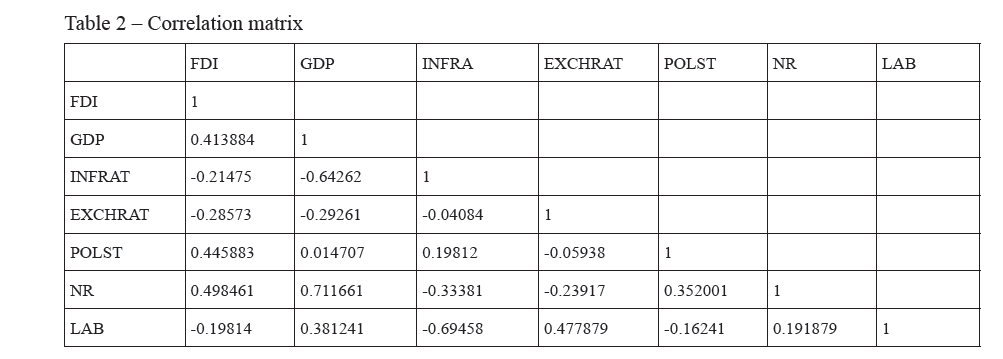
Based on the above Table 2 the study shows that FDI is strongly positively correlated with natural resources with 0,498, also with political stability 0,445, GDP with 0.413, whereby this indicate the presence of integration in the market and it may be due to the high inflow of capital in the country`s economy. Also, the study found that FDI is weakly negative correlated with exchange rate with -0.285 and with inflation rate -0.214 and with labour cost -0.198. Other variables that showed strong positive correlation were GDP and with natural resources 0.711, GDP and labour cost with 0.381, exchange rate and labour cost with 0.477 also political stability and natural resources with 0.352 while weak negative correlation was found between GDP and inflation rate with -0.642, also between inflation rate and exchange rate with -0.040, inflation rate and labor cost with -0.694, inflation rate and natural resources with -0.333, also between exchange rate and natural resource with -0.237.
Table 3 – Regression Statistics summary

Table 4 – Combination association and ANOVA of dependent variable with independent variables.

The above table 4 represents combined association that is found strong, positive and significant with FDI. It assesses the overall significance of the model, hereby F is insignificant at 0.000 level which verifies that 81% of the variance in FDI can be accounted for by Natural resources, political climate, GDP, labour cost, inflation rate and exchange rate.
Table 5 – Regression results
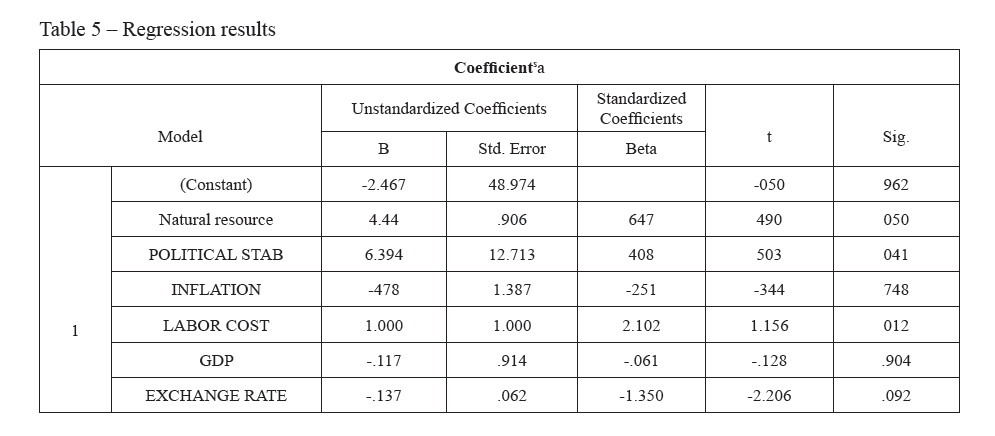
The regression model is FDI rate = -2.46-0.137(Exchange rate) -0.117(GDP) – 0.478(INF) + 6.394(Political Stability) + 1.0 (Labor cost) + 0.444 Natural resource.
Estimation Results.
The multiple regression model summary presented above indicates that the value of our R-squared is and is significant; this implies that the regression model explains 81 % variation in FDI inflow motives in Kazakhstan for the period under the The F statistic's value is 2.875 which show that the model is a good fit, and the probability of F statistics is 0.0000; this indicates that the results are statistically significant. The regression tables above show that variables of Gross Domestic Product and Inflation rate and Exchange rate are not statistically significant, whereby the coefficients for these variables are negative. GDP is used here as a proxy for country market size. The coefficient value of GDP growth rate was –0.117 %, which was not significant, t= 0.128, p> 0.05, i.e. FDI change less than proportional for a given change in GDP. This implies that FDI in Kazakhstan was found not to be very responsive to GDP, whereby most of the Central Asian countries have a relatively small domestic market, thus low growth rate and GDP per capital cause Kazakhstan to have no exception. It suggests that the market size is not a motive factor of FDI inflow into the country.
The inflation rate is also one of the variables, which used to capture macroeconomic stability. In this study, the inflation rate was found insignificant to FDI inflow whereby the coefficient of an inflation rate was -0.478%, t= -0.344, p> 0.05. Empirically, Azam (2010), find out that positive effect of market size, official development assistance on FDI and the negative effect of inflation on FDI inflows in Turkmenistan. Market size and inflation in Armenia, and market size and official development in the Kyrgyz Republic found statistically significant. However effect of official development assistance in Armenia and the effect of inflation on FDI inflows in the Kyrgyz Republic found insignificant. [8].
Thus implies that these two variables GDP and inflation rate have the negative impact on the total amount of FDI inflows to Kazakhstan.
The exchange rate is another variable that used to determine macroeconomic stability. The results reveal that the exchange rate is significant in explaining changes in FDI. Fluctuation of exchange rate factor is the most important factors in group factors. On the other hand, the reasonable factors are not statistically affected by these factors when making their investment decision in Kazakhstan. In particular, fluctuation of exchange rate was -0.137%, t= -2.206, p>0.05.The finding is in line with the study done by Muhhamad Azam (2010) who found there is a strong relation between FDI and exchange rate in Kazakhstan and Azerbaijan from 19922010 [10]. A couple of more recent studies on the effect of uncertainty on the level of private investment are by Serven (2003) and Pradhan, et al. (2004) study is based on cross-country time series data for 61 countries for the 1970-1995 period and finds a strong negative effect of real exchange rate uncertainty on private investment [9].
Furthermore, political stability is found to be significantly and positively related to FDI inflow, with the coefficient value of 6.394% simply means that FDI is highly responsive to the political stability of the country, whereby based on institution views this factor is an essential element in enabling investment inflow as mostly the investor always prefers to invest in countries where they are politically stable Kazakhstan has been one of the most politically stable countries in Post-Soviet Union countries. Since gaining independence in 1991, Kazakhstan has enjoyed a remarkable degree of peace and stability; this makes Kazakhstan be one of the preferable countries to invest. Empirically, Asiedu (2006) finds that political instability negatively affects FDI inflows in Africa. As many researchers emphasized that political stability one of key factors that affect the FDI. For example, According Haksooon argues that only political risk is an important factor in limiting capital flows. Investments in many developing countries are exposed to large political risks, so FDI inflows are large for politically unstable countries. By the same taken, FDI outflows are large for politically stable countries to invest in countries with large political risk (Kim, Haksoon 2010) [10].
Natural resource availability was found to be significant at 0% and 1% level and it positively related to FDI inflow, whereby the coefficient value of it was 4.44%. This show FDI is responsive to the availability of resources in the country. Natural resources offer a wide range of FDI opportunity in the country example, minerals, arable land and tourism attractions are most favourable areas attract FDI in the country. After Russia, Kazakhstan occupies second among of the CIS countries its quantity of mineral production. It is endowed with large reserves of a wide range of metallic ores, industrial minerals, and fuels, and its metallurgical sector is a major producer of a large number of metals from domestic and imported raw materials. Empirically, a research was done by Ole Therkildsen, Hasen, Buur and Kjaer, 2013 reveal that abundant in terms of natural resources have been a major pulling factor to FDI inflow in most African countries which have similar features of an economy with Central Asian countries.
Labour cost is another variable used in this study, which is also found to be statistically and positive related to the inflow of FDI in Kazakhstan with the coefficient value of 1.000 % simply means that FDI is also responsive to the low and middle labour cost found in the country. Most of the investments are motivated by the pursuit of lower labour cost mainly in the industries that do not need employees who are highly educated like in laborintensive industry's example mining industries. Low wage rates always attract investors whereby; most firms invested in other countries aim at reducing production cost and get higher profit. Therefore, it’s obvious that labour cost plays a significant role in motivating FDI inflow in Kazakhstan. Empirically, Rodriguez and Pallas emphasized panel data to examine the sectorial, regional and macroeconomic variables that have attracted FDI inflows in Spain. They found that labour productivity and the cost of labour are important determinants of FDI in Spain during the period 1993-2002 (Gharaibeh, 2015). Demand, the evolution of human capital, the export potential of the sectors variables in addition to other certain macroeconomic determinants that measure the differential between Spain and the European Union average were also found to play a crucial role in attracting FDI inflows [11].
The findings, based on statistical data indicated that the key factors that determine changes in FDI in Kazakhstan are natural resource, political stability, labor cost, and exchange rate of Kazakhstan Tenge to other currency proxies of the rate of change in the US dollar, although GDP, inflation rate and other factors also play a significant role in the country’s economic growth.
Recommendation
The outcome of these study findings the following are the resulting recommendations. The sensitivity of FDI inflows to exchange rate and inflation rates should be acknowledged. It seems there is a strong relationship between FDI inflows and exchange rate. Exchange rate movements affect FDI values because they not only greatly affect a number of cash inflows received from investments but also affect a number of cash outflows required to pay to continue operating these investments. Currencies appreciate and depreciate according to prevailing market conditions. These movements of exchange rate affect inflation and interest rates which may greatly hamper developing countries economic growth and also lead to reduced FDI levels of Kazakhstan.
Make sustainable Exchange rate and monetary policy. The government needs to introduce some proper monetary policy because the country needs a better currency management system to solve the problem of currency. Further, it is recommended that the policy makers and the government should handle exchange rates with a lot of care so as to properly control FDI inflows into the country. The nation’s monetary authorities should develop and implement measures that will ensure that both inflation and foreign exchange rates are sustained at levels that will ensure an increasing level of inflow of FDI. That current fluctuation is one of the problems that is existing in the country whereby, currency fluctuation in the domestic market is one of the most important economic risks of foreign investment in Kazakhstan. The government needs to introduce some proper monetary policy because the country needs a better currency management system to solve the problem of currency. Apart from that, Kazakhstan should improve its economy in order to attract more FDI compared to the other PostSoviet Union and regional states, thus attracting major companies to operate in the country whereby friendly economic policies and business environment need to be put in place in order to attract FDI into all sectors of the economy. Also, the government should carry out full liberalisation and diversification of all sectors of the economy for foreign investors to be attracted.
Improve business conditions. The country should continue to improve business climate its investment policies and strive to reduce the cost of doing business by creating necessary incentives such as reduction taxes, lowering of interest rate to new investors and granting insurance coverage for investors in each and every established special economic zone.
Incentives and regulations. Bureaucracy and arbitrary applications of laws remain a major problem in Kazakhstan and an obstacle in attracting FDI. The Government should create an authority which will be one investment ombudsman to improve the efficiency and reducing the cost of establishing investment. FDI policy should be developed and easily accessible to investors. Priority sectors should be identified by the government and ensure that FDI is attracted into those sectors by creating necessary incentives to the investor.
Improve of skills labor force. Investors often worry about the shortage of managerial talent and skilled personnel in the country. While the authorities have been taking steps to address this issue, progress will take time. Because of this, businesses should look to develop their own talent by setting up in-house training centres. They can also partner with the state to open up vocational centres for students in their industries. Hightech, telecommunication and business services companies are particularly affected by this skills shortage, because of the high demand for skilled personnel in their industries [12].
In addition, investment promotion and facilitation service should be brought up to international standards. Also the country’s investment authorities, organizations and agencies should enhance investment promotion campaign. This will ensure that Kazakhstan attracts high-quality Foreign Direct Investment portfolio that would lead to meaningful economic and social development in the country.
References
- Agosin M. , Mayer R. Foreign Investment in Developing Countries: Does It Crowd in Domestic Investment? // UNCTAD paper. – 2000. – № 146.
- Asiedu, Foreign Direct Investment in Africa: The Role of Natural Resources, Market Size, Government Policy, Institutions and Political Stability // World Economy. – 2006. – № 29 (1). – pp. 63-77.
- Asian Development Bank Outlook Financing Asia’s Future Growth [Electronic source]. – 2015. URL: https://www.adb.org/sites/default/files/publication/154508/ado-2015.pdf (accessed: 05.2017)
- Kalieva M. Прямые иностранные инвестиции в Казахстан в 2017 году [Электрон. ресурс]. – 2017. – URL: www.rfcaratings.kz (accessed: 05.2017)
- EDB Centre for Integration Studies, Monitoring Mutual Investments in the CIS [Electronic source]. – 2014. – URL: https://eabr.org/en/analytics/integration-research/cii-reports/monitoring-of-mutual-investmentsin-cis-countries-2017/ (accessed: 16.05.2017)
- Economic indicators for over 200 countries [Electronic source]. – 2015. – URL: theglobaleconomy.com (accessed: 16.05.2017)
- Azam Muhammad, Economic Determinants of Foreign Direct Investment in Armenia, Kyrgyz Republic and Turkmenistan: Theory and Evidence // Eurasian Journal of Business and Economics. – 2010. – № 3 (6). – pp. 27-40.
- Azam Muhammad, The Determinants of Foreign Direct Investments: Evidence from Azerbaijan and Kazakhstan. – 2010.
- Kim, Haksoon, Political Stability and Foreign Direct Investment // International Journal of Economics and Finance. – 2010. – № 2 (3). – pp. 59-71.
- Ahmad Mohammad, Obeid Gharaibeh, The Determinants of Foreign Direct Investment-Empirical Evidence from Bahrain // International Journal of Business and Social Science. – 2015. – № 6 (8). – pp. 94-106.
- EY's attractiveness The brand paves the way. Kazakhstan-2014. – 2015.